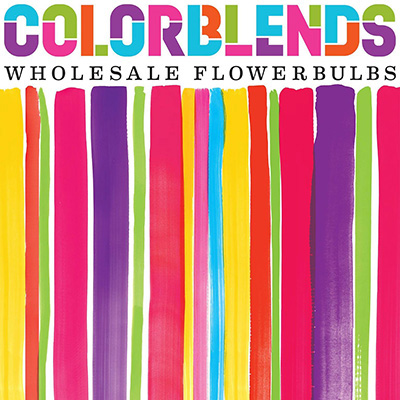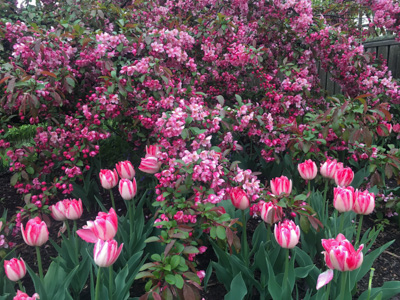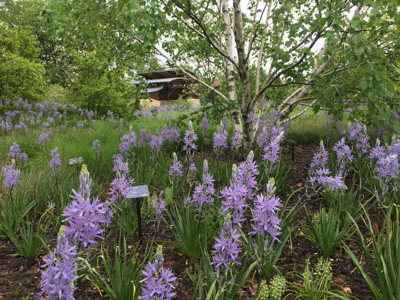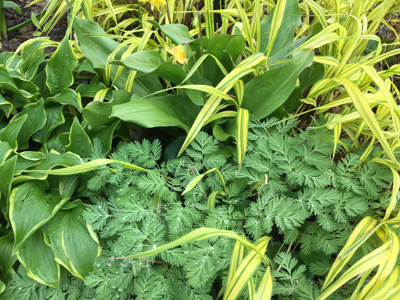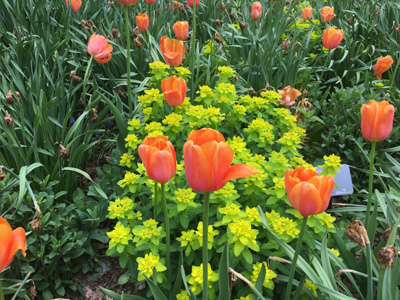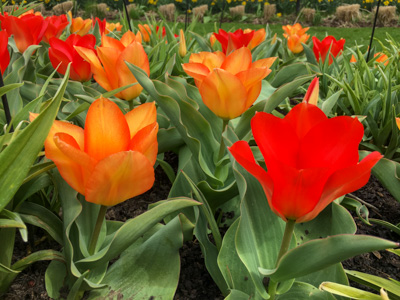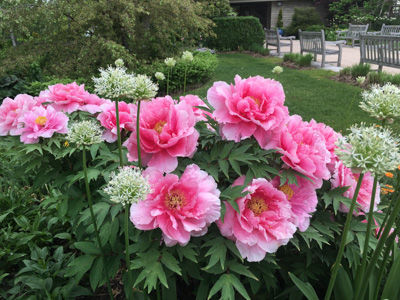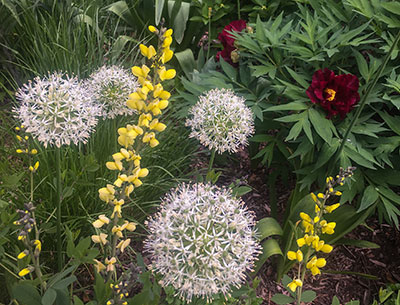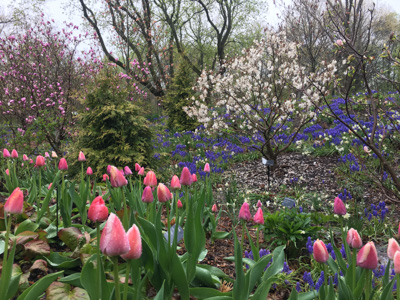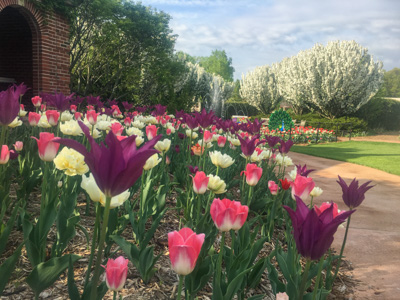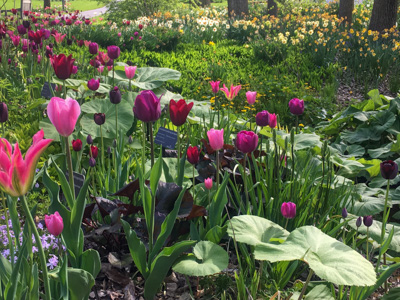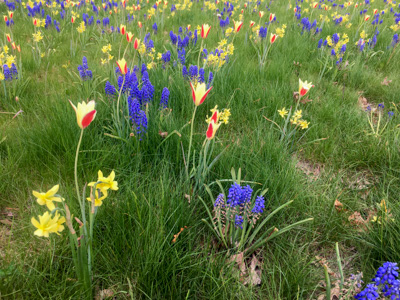Mark Konlock
Design Notes
Pink Tulips and Crabapple Blossoms
Combo: Tulipa ‘Foxtrot’ with Malus sargentii ‘Candymint’ (Sargent crabapple).
Location: Green Bay Botanical Garden, Green Bay, Wisconsin, USDA Zone 5a
Notes: I find it especially elegant to color echo when underplanting spring-flowering trees and shrubs with spring bulbs. For this effect, nothing beats the exuberance of tulips. Here two-toned pink Tulipa ‘Foxtrot’ takes the impact of similarly colored ‘Candymint’ Sargent crabapple up a notch. Under a softer pink crabapple canopy, I like pale pink Tulipa ‘Angelique’ or rosy Tulipa ‘Aveyron’.
With massed beds of a single tulip variety, I lean towards double-flowered tulip varieties like ‘Foxtrot’, ‘Angelique’ and ‘Aveyron. Double flowers last longer in the landscape since they do not have the sexual parts to produce seed; other types drop petals once fertilization occurs and energy is put into seed production.
Wet and Wild
Combo: Camassia leichtlinii ‘Caerulea’ (purplish blue, blooms late season) with Carex flacca (blue sedge) and Carex vulpinoidea (fox sedge). With Betula utilis var. jacquemontii (white-barked Himalayan birch).
Location: Green Bay Botanical Garden, Green Bay, Wisconsin, USDA Zone 5a
Notes: At GBBG, in late spring, this river of sedge attracts a lot of attention. But, it’s not the sedge that captivates. People love the blue flower spikes of the Camassia bulbs planted randomly across the grassy slope.
Camassia, sedge and Himalayan birch all thrive in moist soil. The Camassia adds flower power to the texture of the grassy sedges, while the textured white bark of the Himalayan birch accentuates the purple-blue flowers. It’s a combination where the components mesh well, while upping the ante for one another. (A similar but different effect could be achieved with a rust-colored paperbark birch instead of the white-barked birch.) Mass plantings of the same bulb flower in spring give any setting grander scale. The same effect is achieved by massing the sedge, which leads one’s eye through the garden to the pavilion, further back.
Vignette in Yellow-Green
Combo: Trout lily ‘Pagoda’ (Erythronium, yellow flowers, bright-green leaves with brown mottling, blooms in the early-mid season) with Dutchman’s breeches (pendant white or pale-pink flower, feathery, blue-green foliage, blooms early spring); Hosta ‘So Sweet’ (variegated, soft green, yellow); and Hakonechloa macra ‘Aureola’ (Japanese forest grass).
Location: Green Bay Botanical Garden, Green Bay, Wisconsin, USDA Zone 5a
Notes: Trout lilies are nice spring ephemerals to add to a shade garden. There’s a wildflower look to the yellow flowers with reflexed petals, which are held on wiry stems above wide green mottled leaves. Plant the bulbs en masse or in clusters to create little vignettes. Though you see only a few in this photo, there are actually dozens of trout lilies planted in this area.
This four plant ensemble features two spring ephemerals, Trout lily and Dutchman’s breeches, with hosta and Japanese forest grass. All four are at home growing in damp, humus-rich soil in woodland settings with dappled light. Especially noticeable are the different foliage textures and colors, plus the subtle reverse color echoing of the hosta and Japanese forest grass. Details like these make for a more sophisticated experience in the garden that people often appreciate without even knowing why. The bloom comes in two waves, each lasting several weeks: first the Dutchman’s breeches, then the trout lilies. After bloom, the spring ephemerals fade over time and go dormant. The hostas and grasses keep going, looking good into fall.
Ideas Worth Snitching
Combo: Tulipa ‘Dordogne’ (pink/salmon brushed with orange, blooms late season) with Euphorbia polychroma (cushion spurge, chartreuse, perennial, blooms mid to late spring).
Location: Green Bay Botanical Garden, Green Bay, Wisconsin, USDA Zone 5a
Notes: One of the great things about gardening is trying out new combinations, including ones you’ve seen at other gardens and added to your “snitch file” for future inspiration. Here’s one I saw at the Paine Art Center and Gardens in Oshkosh, Wisconsin and borrowed for our garden. Tulipa ‘Dordogne’ with Euphorbia polychroma—I just love the contrast between the tulips and the mounded spurge. Together, these two really light up a cloudy day. That chartreuse almost shines its own light! When the tulips fade, the Euphorbia polychroma carries on. In fall, depending on the Euphorbia polychroma variety you’ve got, the medium-green leaves turn red, orange or purple.
Daylilies and Tulips, Perfect Together
Combo: Emerging daylily foliage with Colorblends Tulip Blend Apples to Oranges™ (fire engine red and pumpkin orange with red flecks, blooms in the early-mid season).
Location: Green Bay Botanical Garden, Green Bay, Wisconsin, USDA Zone 5a
Notes: Many gardeners incorporate daylilies into their gardens for their ease of establishment, grass-like foliage, and midsummer blooms. All of these characteristics also make daylilies ideal partners for spring bulb flowers. As early-emerging daylily foliage fills out, it complements spring’s progression of bulb flowers, from daffodils through tulips and alliums. Adding tulips gave us another season of color from the daylily bed. It’s an easy way for anyone who gardens with daylilies to do the same.
I chose this tulip blend for its vibrant orange and red colors and early-mid season bloom. At this point, the emerging daylily foliage is sized just right to frame the tulips, which stand 12- to 14-inch tall. The big flowers on short stems—plus tight spacing—made the tulips appear to be a ground cover among the daylily foliage. As the tulips died back, we deadheaded them and eventually cut off any visible dried foliage.
White Alliums and Tree Peonies
Combo: In the foreground, white Allium ‘Mount Everest’ with pink Paeonia ‘Hanakisoi’ (a large-flowered tree peony). To the rear: a complementary swath of white alliums, this time with variegated Solomon’s seal, under a canopy of weeping crabapple.
Location: Green Bay Botanical Garden, Green Bay, Wisconsin, USDA Zone 5a
Notes: These beauties dominate in their late-spring, early-summer timeframe. After they fade, a completely different summer show takes over. In the photo, emerging perennials play the role of understory. Soon they will take over the bloom scene. The mix includes Geum, variegated Solomon’s seal, Baptisia, purple coneflowers, phlox, spiny bear’s breeches (Acanthus spinosus) and more.
As the summer perennials gain size, they mask the allium’s fairly broad, unattractive foliage as it proceeds through dieback. In our naturalized bulb plantings, we leave bulb foliage in place to die back naturally after bloom. During this six- to eight-week stretch, the declining foliage plays a role in recharging the bulbs with energy for next spring’s bloom.
A good rule of thumb with alliums is don’t be skimpy. We group 100 or more ‘Mount Everest’ in any sweep. I like to “dot” the alliums throughout perennials so their ball-shaped blooms float above the bed.
Subtle Repetition of Color
Combo: White Allium ‘Mount Everest’ with yellow Baptisia Decadence® ‘Lemon Meringue’ (false indigo) and black-red Paeonia ‘Thunderbolt’ (tree peony).
Location: Green Bay Botanical Garden, Green Bay, Wisconsin, USDA Zone 5a
Notes: Here you see another combination of Allium ‘Mount Everest’ with perennials in the GBBG’s Crescent Garden. The balled-shaped flowers of the alliums work well as a contrast to the spike architecture of Baptisia. The repetition of the yellow color of the Baptisia flowers and the anthers of the peonies and the alliums is what makes the combination so pleasing.
Layers of Color
Combo: Four magnolias, from left: Magnolia ‘Jane’ (“Little Girl” hybrid magnolia, tight, light-pink-purple flower); Magnolia ‘Coral Reef’ (salmon flower); Magnolia stellata (star magnolia, 3 ½ inch, white flower); and Magnolia stellata ‘Pink Perfection’ (soft pink). With cobalt-blue Muscari armeniacum (grape hyacinths, blooms mid-season) and Colorblends Tulip Blend Wellspring™ (a blend of 7 tulip varieties that bloom together in midseason: cherry red, purple, mauve, some with cream highlights).
Location: Green Bay Botanical Garden, Green Bay, Wisconsin, USDA Zone 5a
Notes: I like the layers of color and drama you get in relating spring-blooming bulbs to flowering trees and shrubs. In this sloped bed, I combined purple-pink tulips and blue Muscari with a backdrop of small-statured magnolias with large flowers in purple-pink, pink-purple and white. The Arborvitae also act as backdrops to the tulips, making them stand out more prominently than they would against bare ground and mulch. Once bulb season tapers off, the perennials will cover the bulb foliage dieback. We allow the grape hyacinth to seed out and spread.
Tulip Promenade
Combo: Malus ‘Adirondack’ (Adirondack crabapple) and Colorblends Tulip Blend Much Niceness® (midseason bloom; a three tulip blend in pink, white and purple)
Location: Green Bay Botanical Garden, Green Bay, Wisconsin, USDA Zone 5a
Notes: Given our six month winter, we have a special affinity for colorful spring bulb flowers. What I love myself is their elegant form—and that they’re so easy to grow. Just plant them in fall, in spring they come up. You get an explosion of color with very little work involved for such a spectacular show. We keep planting more. I’d say we’re addicted to them.
In our big displays, we often showcase Colorblends tulip blends in combination with flowering crabapples. As flowering trees and shrubs can bloom for weeks on end, you want to choose tulips that are likely to keep them company for most of that time. That’s another reason for choosing Colorblends—extended bloom is their specialty.
In fall, we plant tulip blends densely for a blanket of color in spring. After bloom the first spring, we reuse the blends in naturalized areas. We do this by lifting and drying the bulbs, then replanting them in a secondary site that fall. It’s an easy process and, since the tulips are already blended, there’s no confusion in knowing which bulbs are what. Once replanted they’ll stay put to rebloom for several more years.
We plant a lot of tulips. Deer and other animals aren’t that big a problem for us because we treat tulip beds with deterrents. In fall we spray the ground with Liquid Fence® then use a hand-spreader to cast dry Milorganite® over the ground. In spring, we reapply the Liquid Fence weekly till bloom. Chipmunks will eat some bulbs.
Tulip Blend with Perennials
Combo: Colorblends Tulip Blend Pinotage™ with dark-leaved Ligularia ‘Britt Marie Crawford’ (leopard plant), purple-flowered moss phlox, large-leaved Japanese butterbur, yellow marsh marigold, Camassia, and various daffodils
Location: Green Bay Botanical Garden, Green Bay, Wisconsin, USDA Zone 5a
Notes: Colorblends Pinotage is a versatile tulip blend of six varieties that is somehow both delicate in beauty and robust in performance. Its bloom time is mid-late through late season. We plant the bulbs in informal clusters among early-blooming perennials. As the early perennials get bigger, and others join in, they mask the bulb foliage during dieback.
This is a popular walk that approaches a bridge over a soggy swale where storm runoff water drains through part of the garden. I wanted to see color here spring through late summer, always with lush foliage. In the swale, I planted damp-loving, large-leaved summer perennials plus two unusual spring bloomers that love sun and thrive in damp soil: yellow-flowered marsh marigold and blue-flowered camassia. Just a bit higher, and a whole lot drier, are the tulips, daffodils and other perennials. Overall, the effect is lively and charming.
Naturalized Bulbs in No-Mow Grass
Combo: Tulipa ‘Tinka’, Narcissus ‘Hawera’ and Muscari armeniacum (grape hyacinth) with no-mow grass mix.
Location: Green Bay Botanical Garden, Green Bay, Wisconsin, USDA Zone 5a
Notes: For a meadow effect, definitely use enough bulbs to make an impact. And choose types that are likely to perennialize or naturalize, such as species tulips, miniature daffodils, and specialty bulbs.
For a site like this, we use a quick, easy technique to plant handfuls of bulbs in larger holes: Use a shovel to dig up a chunk of sod. Throw the bulbs in, then replace the sod and tamp down. For a natural look, position the holes randomly, some closer together than others. Place varying numbers and types of bulbs in the holes. Some groupings should be all of a kind, as if spread by nature. Fall rains initiate rooting. In spring, the flowers come up in flowering-bulb bouquets.
In a full-sun setting with well-drained soil, bulbs like these can naturalize and multiply over time. Always let the bulb foliage die back before any mowing so that the bulbs can rejuvenate to bloom the next year. Better yet, plant in no-mow grass and just let the whole works take care of itself.
